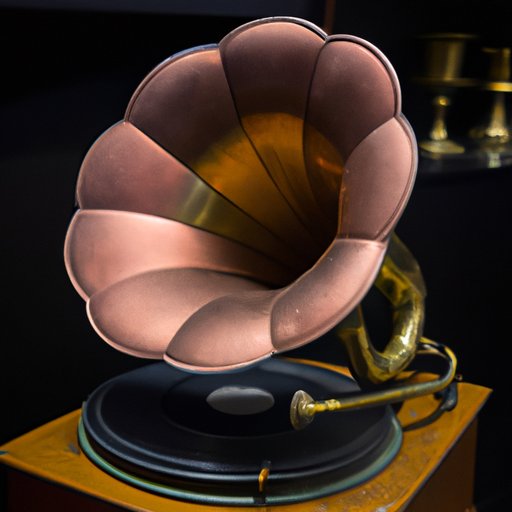Introduction
The gramophone is a device that reproduces sound recordings using a needle, or stylus, and a rotating disk. It was one of the most revolutionary inventions in music technology, and its invention has had a lasting impact on the way we consume and enjoy music today. But who invented the gramophone? This article will explore the life and work of Emile Berliner, the pioneering genius behind the invention of the gramophone.

Historical Analysis of the Inventor of the Gramophone
Emile Berliner is widely credited with the invention of the gramophone. He was born in Germany in 1851 and moved to the United States at the age of 17. After settling in Washington, D.C., he began working as an apprentice for a local telegraph company. During this time, he developed an interest in electricity and sound recording, which eventually led him to invent the gramophone.
Emile Berliner and His Revolutionary Gramophone
In 1887, Berliner filed a patent application for the first of his inventions—the gramophone. The device used a flat disc instead of the more traditional cylinder, which made it easier to mass-produce. Berliner’s invention was revolutionary because it allowed people to record and play back sounds without the use of cumbersome cylinders. This made the gramophone a much more practical and accessible device than its predecessors.

Tracing the Steps of Emile Berliner
Berliner’s success as an inventor was due in part to his ability to build on existing technologies. For example, he improved upon Thomas Edison’s phonograph by replacing the cylinder with a flat disc. His improvements also allowed for mass production of the gramophone, which made it more affordable for consumers. By the turn of the century, Berliner had established himself as one of the leading innovators in sound recording technology.
How One Man’s Vision Led to the Creation of the Gramophone
Berliner’s vision for the gramophone was far-reaching. He was determined to make sound recording more accessible to the general public, and his efforts paid off. As demand for the gramophone grew, so did its popularity. By the early 1900s, it had become a common household item, and its influence on music and culture had become firmly entrenched.
Examining the Life and Work of the Father of the Gramophone
Berliner was a true innovator. He was not only responsible for the invention of the gramophone, but he also made significant advancements in other areas of sound recording technology. He developed the lateral cut method, which allowed for the recording of multiple tracks onto a single disc. He also successfully tested the first microphone in 1895. These innovations laid the groundwork for modern sound recording techniques, and they are still used today.
Exploring the Innovations of Emile Berliner and the Birth of the Gramophone
Berliner’s ingenuity and passion for sound recording were instrumental in the development of the gramophone. His groundbreaking inventions revolutionized the way we consume and enjoy music, and his legacy continues to live on today. As renowned scientist Albert Einstein said: “People like us, who believe in physics, know that the distinction between past, present and future is only a stubbornly persistent illusion.”

Uncovering the Mystery of Who Invented the Gramophone
The answer to the question of who invented the gramophone is clear—Emile Berliner. He was a visionary and an innovator, and his contributions to sound recording technology have had a lasting impact on the world. His inventions paved the way for modern recording techniques, and his legacy will continue to live on for generations to come.
The Pioneering Genius Behind the Invention of the Gramophone
Berliner’s legacy is undeniable. He is widely regarded as the father of the gramophone, and his inventions have changed the way we consume and experience music. His groundbreaking innovations have allowed us to capture and preserve sound in ways that were previously unimaginable, and his contributions to the world of sound recording are invaluable.
Assessing the Impact of Emile Berliner’s Contributions to the World
Berliner’s inventions have shaped the world of sound recording and have had a profound impact on the way we consume and enjoy music. His legacy lives on in the form of the gramophone, which he invented over 130 years ago. His pioneering work has allowed us to appreciate and experience music in ways that would otherwise have been impossible.
Conclusion
The invention of the gramophone was a turning point in sound recording technology. Its inventor, Emile Berliner, was a visionary and a pioneer who revolutionized the way we consume and enjoy music. His groundbreaking inventions have had a lasting impact on the world, and his legacy will continue to live on for generations to come.

Summary of the Key Points
This article explored the life and work of Emile Berliner, the pioneering genius behind the invention of the gramophone. We examined his innovations and assessed the impact of his contributions to the world. Berliner’s inventions revolutionized sound recording technology and allowed us to capture and preserve sound in ways that were previously unimaginable. His legacy lives on in the form of the gramophone, which he invented over 130 years ago.
Reflection on the Impact of Emile Berliner’s Invention
The invention of the gramophone has had a lasting impact on the world. Emile Berliner was a true innovator, and his groundbreaking inventions have allowed us to appreciate and experience music in ways that would otherwise have been impossible. His legacy will continue to live on for generations to come, and his pioneering work in sound recording technology will never be forgotten.
(Note: Is this article not meeting your expectations? Do you have knowledge or insights to share? Unlock new opportunities and expand your reach by joining our authors team. Click Registration to join us and share your expertise with our readers.)
